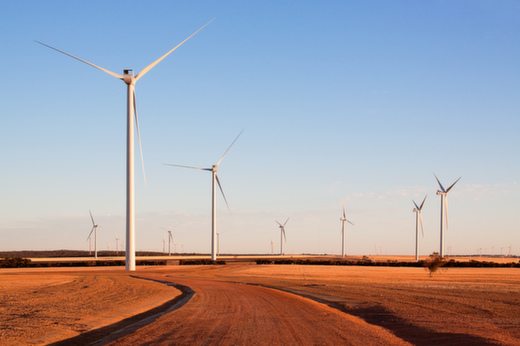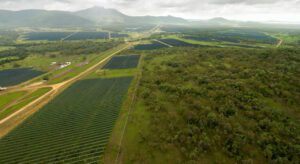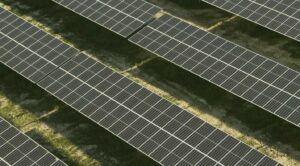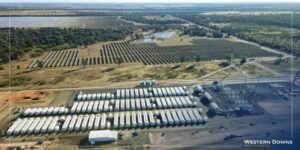The Australian Energy Market Operator has warned that regulators and rule-makers need to act quickly to encourage the adoption of new technologies needed to deal with Western Australia’s rapid uptake of rooftop solar and other renewable energy technologies, and avoid risks to grid security.
The W.A. grid is a fascinating one for observers of the clean energy transition, but a potential headache for the market operator whose job it is to keep the lights on amid an incredible pace of technological change.
The state doesn’t have a huge amount of large-scale wind and solar, and after a brief flurry of investments the “house full” sign may soon be erected for new large-scale projects under its rigid access regime (see blue dotted line in graph below), but W.A. does rival South Australia in its uptake of rooftop solar by households and businesses.
And because it is an isolated grid, it cannot depend on other states.
 AEMO is warning that within three years the amount of operational demand – as households and business continues to install solar at a rapid rate – could fall below 700MW, a level it considers will put voltage levels at risk, unless it can encourage the adoption of new technologies.
AEMO is warning that within three years the amount of operational demand – as households and business continues to install solar at a rapid rate – could fall below 700MW, a level it considers will put voltage levels at risk, unless it can encourage the adoption of new technologies.
And the number of negative pricing events could also soar – up to 40 per cent of the time as the so-called “duck curve” takes dramatic effect. (See graphs at the end of story).
AEMO argues that there are technologies available to deal with this, such as “synchronous compensation”, tighter inverter standards, and batteries. But unless the regulators move quickly to change the rules of the market, they won’t be brought on quickly enough or in sufficient quantities to avoid a potential crisis.
“The market is in a period of transition from the existing historical capital stock to a new capital stock – the fundamental problem is that the regulatory framework was not designed to accommodate this new reality,” the authors of a new report published by AEMO say in a recent presentation in Perth.
The team recently completed a detailed study of how the increase in rooftop solar PV – already at more than 1GW and forecast to continue growing at 150MW to 200MW a year – will push operational demand below 700MW and create potential voltage issues.
 The AEMO modelling took the month of October, 2018, as an example and extrapolated this over the coming 10 years to see how the grid would perform. October was chosen because in the sunny, mild temperatures typical of spring, demand is at the lowest and the solar output is high.
The AEMO modelling took the month of October, 2018, as an example and extrapolated this over the coming 10 years to see how the grid would perform. October was chosen because in the sunny, mild temperatures typical of spring, demand is at the lowest and the solar output is high.
The modelling included various combinations of synchronous generation, online and off line, ramp rate considerations, transmissions lines and the minimum generating thresholds.
“System security risks are emerging now as the increase in large-scale renewable generation displaces the dispatchable thermal generators that presently provide most of the system security services such as inertia, frequency control, system strength, and voltage control,” it says.
“Technical standards and regulatory and market constructs require carefully designed but urgent change, to implement or incentivise new technologies in the SWIS (South West Interconnected System) such as synchronous compensation, energy storage, and increased inverter capabilities.
“These changes will support the management of power system security and effectively integrate renewable generation and DER in a way that facilitates efficient utilisation of existing and future electricity source.”
The message was reinforced in a separate presentation by AEMO chief executive Audrey Zibelman, who noted that the capacity of rooftop solar in the SWIS (1,000MW in a 4,000MW grid) was already three times the size than the biggest thermal generator.
“Fundamental change is required” to existing regulatory and market constructs, Zibelman told the Committee for Economic Development in Australia in Perth, adding that she welcomed the W.A. government response, setting up a task force to plan a path for the likely exit of coal, and presumably to deal with the issues which will be presenting themselves over the next three to five years.
Zibelman talked of the importance of “adaptive regulation”, and moving on from a regulatory environment that assumed certain constructs, such as slow technology change and investments that last decades.
These two graphs (above and below), highlight some of the issues for the grid operator, and generator owners. The top notes the expected proliferation of negative pricing events with the growth of rooftop solar over the coming 10 years.
This will happen up to 40 per cent of the time at its peak in 2021 and could continue at high rates until at least 2028, unless there is a market redesign.
Zilbelman, in her speech, also took note of the deepening “duck curve” in W.A. as the growth in solar continued.










